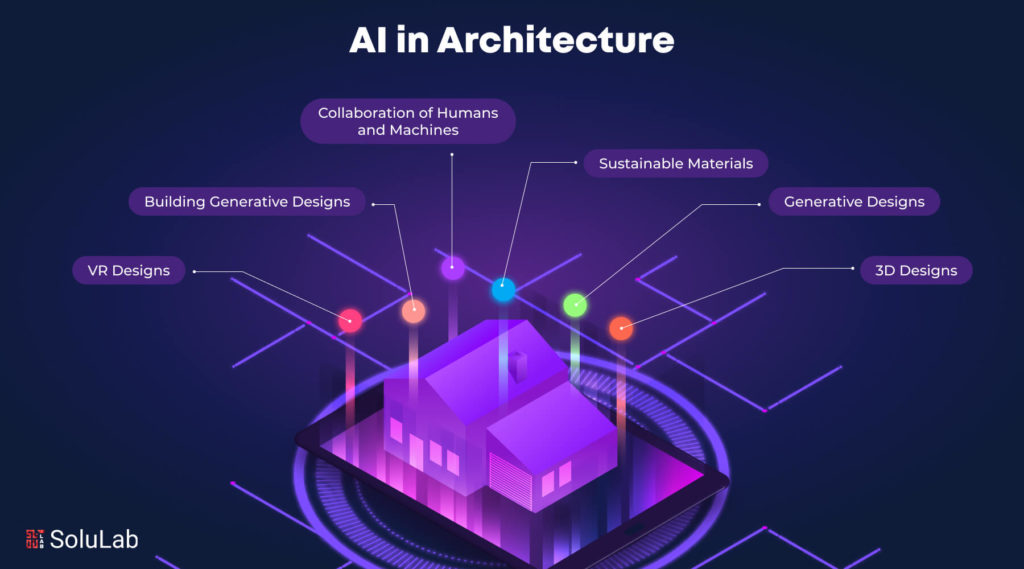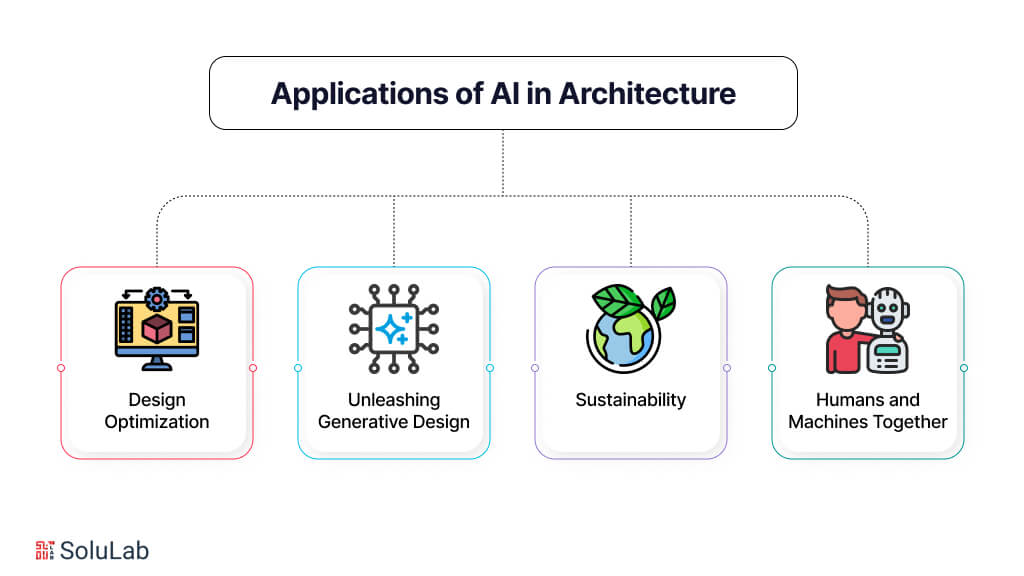
Artificial Intelligence (AI) is profound to be the most evolving technology in the world. AI has successfully paved the way in architecture’s design and building field. According to the American Institute of Architects, about 90% of Architects in the United States are using AI in Architecture by planning construction, designing layouts, processing data, and management. Collaboration is building the future, AI with human capabilities allows humans to process high-order designing and decision-making. AI-generated architecture is innovative with AI analysis and designing diverse designs that stand out
What is AI in Architecture?
Artificial Intelligence in Architecture is designed to change the whole perspective of the world. The Role of AI in Architecture is its ability to come up with different and creative ideas, handle a lot of information and make complex tasks easier for humans. There has been a gradual increase in the demand for AI-generated architecture designs. This is because the core elements of Artificial Intelligence in Architecture are Collaboration, Data Analysis, Generative Designs, improved efficiency, construction monitoring, and sustainable designs. It is easier for machine learning models to adapt to changes, maintain workflow, and minimize the need for manual directing. The ability to build a 3D model and virtually represent the build gives a better chance of working on the imperfections and adding the creative touch if required. The strong fear of AI removing architects and designers exists in society, but it is most unlikely to happen because AI can never manually analyze the situations. AI use in architecture is a powerful tool, but so is handling the tasks and looking after its working. As the advancements in AI-generated architecture continue, AI-generated designs will tend to be accessible, and creative, always offering a unique way to build architecture which will be properly analyzed to foster the growth in the field of Architecture.
How is AI involved in the design process?
1. Efficient
AI in Architecture is based on computer designs that mimic human response and can solve complex problems with the help of machine learning. AI has been pretty relevant in the design process. Starting from imagery layouts with the use of the Internet to building information models, AI is doing all the brainstorming for you. Unlike assistants, it is easier for AI to automate repetitive tasks like resizing images, preparing imagery layouts, and providing insight into color palettes.
2. Creative
Not able to think outside the box? AI got you covered! Architectural AI offers generative designs that use a set of rules and algorithms to explore the vast amount of designs available on the internet for you. Architects and designers can easily put inputs, directions, and material limitations, and other necessary information, AI will then produce a unique solution for all your needs. It gives a push to your creativity and boundaries for unseen possibilities.
3. Sustainable
Everyone is moving together for a sustainable future, and so is AI. AI possesses the ability to design according to weather patterns, materials used, and energy uses, this gives the architects to proceed concerning the environmental impact their actions may have. For instance, AI can provide suggestions regarding lower carbon footprints, and placing windows for natural light. It will provide even more solutions that we know of to save the planet with every construction.
4. Human Touches
Architects will be able to use AI as a helpful tool, but other talents will remain applicable. Architectural design AI is perfect for processing information and making recommendations, while creativity, understanding of people’s emotions, and people’s nature remain extremely relevant. In a shared future, AI will enhance the strengths of people, to allow architects to focus on the higher-value aspects of their work. The next time a complex or cultural piece of architecture is done creatively or with consideration for the environment, remember that for architects AI has become the new shadow.
How is AI Building Different From Traditional Planning?
Physical models and hand-drawn sketches which include a lot of drawing ability and manpower strength have been part of the architectural design process. Despite this, these techniques have delivered fabulous buildings, it is equally true that the emergence of artificial intelligence (AI) is ushering in a new age of design. Architectural AI is not merely a swap of traditional planning, which is what artificial intelligence provides instead.
Traditional architecture, or the planning procedure, is meticulous and centered around people. Architects depend on:
- Experience and Intuition: Decades of experience and innate feelings help to make the right decision regarding the design. The architects apply their knowledge base when coming up with the best way of solving a particular problem irrespective of the issues like beauty, usefulness, or usability.
- Iterative and Linear: AI for architecture is a cyclic process where one step follows the other in developing a design for the intended product. However, iteration is not excluded by this. Often, the architects traverse from one phase to another while adjusting the design accordingly.
- Limitations on Data Dependency: Data is employed in conventional planning, though often it concerns only the site surveys, construction norms, and precedents. The ability of a human to analyze big data and search for complex patterns is still a weak one.
A unique set of skills provided by AI revolutionizes the planning process:
- Data-Driven Design: AI performs optimally with big data as it relates, at times to the users behavior, material properties, weather and so on. Therefore, architects are in a position to make more informed decisions concerning the design of structures and aspects such as load-bearing capability, comfort, and energy usage.
- Generative Design: This helps to explore a large design space because AI algorithms are set to work with pre-existing parameters. This fosters a higher chance of designing creativity and innovation because it results in the designing of an enormous number of unique design variations. Picture an AI designing with the intent of designing perhaps how much light is to be let into a room or perhaps having an idea of which of the sustainable materials is best paired with another.
- Predictive Analytics: AI can predict such challenges that may arise in construction or the building’s performance over time given the previous AI trends. It becomes easy to arrange in advance and to minimize the risks; this in turn prevents time wastage and expenses.
Cooperation is Essential
Still, despite all the pros of using AI, the main point to always recall is that it is impossible to have architects replaced by AI. Some possible benefits of architectural design AI can be the identification of patterns, finding solutions to the problem, and data analysis. However, creating knowledge that can be leveraged to define a novel course of action, to interpret situations and decisions, and to willingly involve oneself in the human condition are critical things that only humans can do. In architectural planning, collaboration is the key to the future:
Human-centric AI posits that when it comes to intelligence, rather than replicating human capabilities AI should augment them. All those people will still be needed to set the goals of the design, to process information, and to make sure that the design as the final result fits the environment and user needs. One of the major ethical dilemmas is that AI algorithms, including machine learning algorithms, are only as good as the data that is fed into them. Artificial intelligence awareness can be achieved by architects ensuring that they are cautious of any existing prejudices within the data
Applications of AI in Architecture

This change in the architectural scene is by artificial intelligence (AI). The technical term that has recently got out of the realm of sci-fi and become integrated into every facet of design starting with the concept and ending with the very last poured concrete. Let’s examine a few fascinating uses of AI in the field of architecture:
1. Design Optimization
Imagine an efficient assistant in the constant search for the most optimal solution. Consumer databases, code related to construction, and environmental factors are some of the substantial data sets that can be reviewed by the application of AI in architecture. This grants architects the leeway to develop structures that are not only functional but also very artistic. AI can give suggestions on plan configurations that best utilize the spaces, determine movement patterns within a building’s interior, and come up with the best place for windows for natural lighting.
2. Unleashing Generative Design
Do you have difficulties in the first step – idea generation? AI might inspire you. In generative design, AI applies to the generation of many designs according to the set criteria within the large design space. Best look at it as a highly charged brainstorming meeting. One can enter specific design preferences and restrictions for materials as well as the functionality for which the structure is intended. Finally, AI-generated architecture provides several new design options that originate in a seemingly inexhaustible supply of possible ideas and concepts to the ordinary person, while challenging the imagination and maybe creativity beyond that.
3. Sustainability Champion
Artificial intelligence is ready to take an active part and become one of the key allies in the combating climate change process. These environments are within AI’s range of data analysis as it can look into data related to building materials, energy consumption, and weather patterns. Promising solutions seem to be on the way allowing architects to construct buildings that affect the environment to a lesser extent. Suppose an AI system for recommending products with less or no carbon emissions or an AI system to suggest appropriate window positions that improve heater efficiency and less heat gain or loss.
4. Humans and Machines Together
The application of AI in architecture is a functional tool yet it cannot replace real architects. AI excels in gathering data and providing options but without human understanding, intuition, and creativity it doesn’t handle the complete process and procedure of building, and completing the construction. That’s why the future of AI will always be in collaboration with humans to work effectively. This allows architects to focus more on strategy ideas to serve the creative builds that inspire.
Benefits of AI in Architecture
-
Power of Information
The Algorithms and AI technologies are designed to push their boundaries for thorough research which can be a little extra work manually and still not be accurate. AI can track vast databases of existing cultural artefacts, traditional designs, and natural ideas to form a greater one out of them. With the use of several tools such as DALL-E AI gets directions about how to create completely new aesthetics, designs, and innovative ideas that may have been quite difficult to acquire independently.
-
Greater Effectiveness
AI goes beyond design. AI-generated architecture Management systems allow optimization of the building performance in real-time based on data collected by sensors. This may reduce the energy consumed, cut maintenance costs, and increase the comfort levels of the occupants. Hear about buildings that can adjust the temperature and lighting based on the current occupancy levels!
-
The Sustainable Design Revolution
Sustainability in structures is emerging to be a significant consideration for architects in the current world. To achieve sustainable solutions, AI can look into material attributes and energy consumption patterns, climate data, and much more. This could involve recommending energy-efficient methods of construction, searching for materials that have a lesser effect on the environment, or even how the building can be positioned to allow sufficient natural lighting and airflow.
-
Data-Driven Decision Making
For quite a long time, the decisions on designs were mostly made instinctively and without much worries about their impacts. They are the extension of data analysis that provides a lot of information to make the right decision. With the help of machine learning algorithms, it can predict energy consumption in a building regarding various designs or look at records to conclude that users prefer specific areas. Hence, the use of such data-driven methodologies leads to the creation of more user-centric and optimized designs.
Conclusion
In this blog, we delve into how the architecture industry is experiencing the integration of Artificial Intelligence. The 2030 Palette is a resourceful instrument for architects where they can find valuable information to produce efficient designs for the future. Artificial intelligence architecture design helps to eliminate time-consuming tasks so that architects can work more personally on more creative and strategic functions. As for actual day-to-day tasks, they can offer numerations or other data manipulations regarding the building performance to create the designs that would have the least negative impacts on the environment. In this manner, AI is applied in collaboration with architects combining the top-flight performance of an artificial intelligence algorithm with an architect’s creativity and intuition to shape the world we will live in by designing the built environment of the future. Ready to design your future with AI? Know how SoluLab can be your AI partner with a wide range of solutions provided. Contact Us Today!
FAQs
1. How is AI stepping up the Architecture Game?
AI has brought a vast database of information, creative ideas, and brainstorming to another level. AI can create multiple possibilities. It can complete repetitive tasks giving more time to architects to focus on the bigger picture. Provides architects with vast databases of energy consumption and material properties so that designers can keep the environment in mind.
2. Can AI replace Architects and Designers?
No, AI is not enough alone to look after all the work on the construction site or even in the office. The process of building in Architecture requires a lot of manual look-after where AI capabilities are not well off. Humans and Machines give the best results when working collaboratively not individually and AI is only working as the right hand or virtual assistant.
3. What are the challenges of using AI in Architecture?
AI works only on the data it is trained on so many responses can be data-biased architects have to keep this in mind. Architects need to make sure AI-generated Architecture aligns with the ethical principles that require human expertise.
4. What can architects do to ensure that AI is being utilized properly?
Before AI is used by architects, project goals, likely user requirements, and sustainable targets need to be described in detail. This ensures that the options developed by AI are relevant, and also assists in guiding it. Thus, architects will be in a better position to leverage this technology should they update their knowledge of the current AI tools as well as the ideal practices within the field. While AI is not a fix-all cure, it is a solution. AI should be used under the architects’ supervision to complement their work, and architects must be able to evaluate and adjust the AI-generated ideas with their expertise.
5. Explain how architects can benefit from AI with the help of SoluLab.
Designing the construction can be enhanced with detailed information acquired from analyzing data sets of the project obtained from the AI tools SoluLab offers. The currently used AI solutions are developed according to the goals and requirements of the project. AI development must be done responsibly and this is not lost on the folks at SoluLab. To ensure that this is the case, we make sure that the tools that we use to develop the designs are derived from measurable parameters and we also advocate for ethical decision-making right from the design phase.






